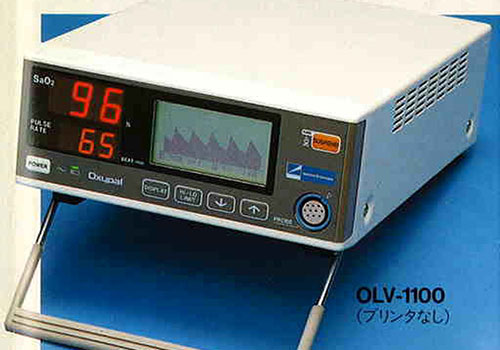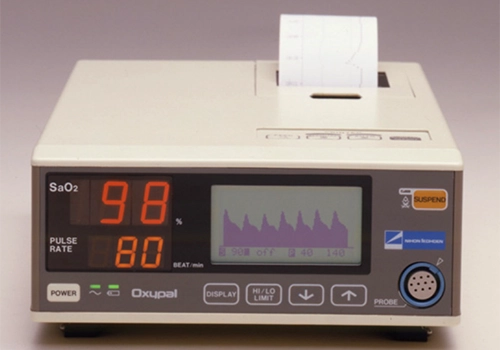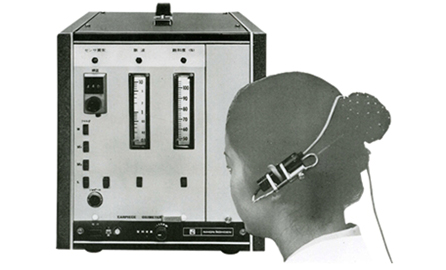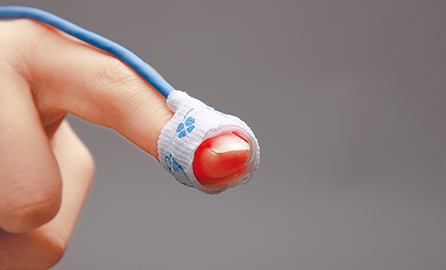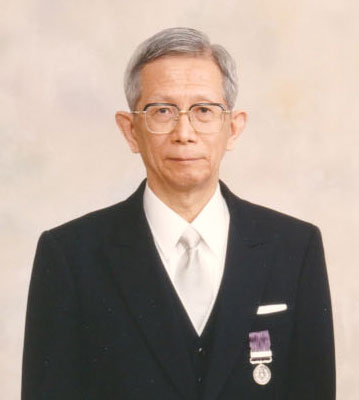
- 拡大
- Takuo Aoyagi
In medical practice around the world, the pulse oximeter is an essential tool for understanding a patient's condition. The principle of the pulse oximeter was invented around 50 years ago by Takuo Aoyagi, an engineer at Nihon Kohden. On this page we present Dr Aoyagi's achievements and the history of the pulse oximeter.
November 14, 2024
The pulse oximeter is a device that continuously measures the oxygen saturation in arterial blood (how much hemoglobin is bound to oxygen) without blood sampling.
Hemoglobin turns bright red when bound to oxygen, and dark red when unbound. The oxygen saturation of arterial blood is calculated by utilizing the fact that the ease of absorbing light differs depending on the color. Two types of light with different wavelengths are emitted from one of the small devices attached to the fingertips of the hand, and the sensor on the other side measures the light that passes through the finger without being absorbed and analyzes it.
It can be fatal if there is not enough oxygen in the blood. Blood sampling does not always provide accurate, real-time information about the patient's condition, which changes over time, but using a pulse oximeter does not hurt the patient, and allows the surgeon to understand in real time, how much oxygen the patient has in their bloodstream.
After graduating from the Faculty of Engineering, Niigata University, Mr. Aoyagi joined the company in 1971 after working for Shimadzu Corporation (Kyoto). One of Mr. Aoyagi's beliefs at the time when he began searching for specific research themes in the development department was, "The ultimate form of patient monitoring is the automation of treatment. To get closer to that ideal, development of non-invasive continuous monitoring technology is important. "
In 1972, while improving the equipment for measuring arterial blood pumped from the heart, we discovered that the oxygen saturation of arterial blood can be measured by using the pulse of the heart.
Mr. Aoyagi later commented on this finding, "It was hard to believe that such a good discovery was waiting for us in such a convenient place."
Mr. Aoyagi, who continued his research, working on the development of prototype devices, presented this principle at a conference in 1974. There were some opinions that "I think it was an interesting study," but there were some negative opinions, so this presentation did not receive much attention.
The following year, in 1975, we launched the "Oximeter OLV-5100", which uses this principle. It was a truly unique and world class product, but there was still room for improvement in terms of performance and usability, such as the light source being a miniature bulb and the fact that the sensitivity of the sensor was poor, and demand for the product never really materialized. For these and other reasons development of the pulse oximeter was eventually suspended.
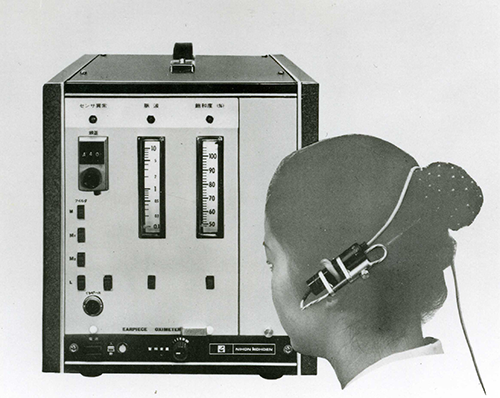
- 拡大
- Ear oximeter OLV-5100
The 10 years after we stopped developing the pulse oximeter, saw a great deal of movement in the medical world. With the frequent occurrence of medical accidents in the United States where patients under anesthesia for surgery lose their lives due to lack of oxygen, the usefulness of pulse oximeters came to the forefront of global attention. With many companies competing to launch smaller devices incorporating new technologies such as LEDs, photodiodes, and microcomputers, pulse oximeters became very popular. This movement spread to the domestic market in the latter half of the 1980s, and we also resumed the research and development of the pulse oximeter utilizing the know-how gained during development of the OLV-5100 and released a new product in 1988.
At the time of the development of this product, there was debate over whether to manufacture it in-house, but Mr. Aoyagi said, "Currently, a single device is the mainstream, but in the future it will be essential to incorporate it into a biological information monitoring device. You should make your own products so that there are no restrictions on what you can do with them.
As expected by Aoyagi, the arterial oxygen saturation (SpO_{2}) is a standard parameter for most of today's biological information monitoring devices.
Mr. Aoyagi did not announce the principle of the pulse oximeter in English, but Dr. Severinghaus, a world authority on respiratory physiology who knew Mr. Aoyagi's existence, visited Japan in 1987 and met Mr. Aoyagi. After that, after being introduced in the paper, Aoyagi became known worldwide as the inventor of the pulse oximeter.
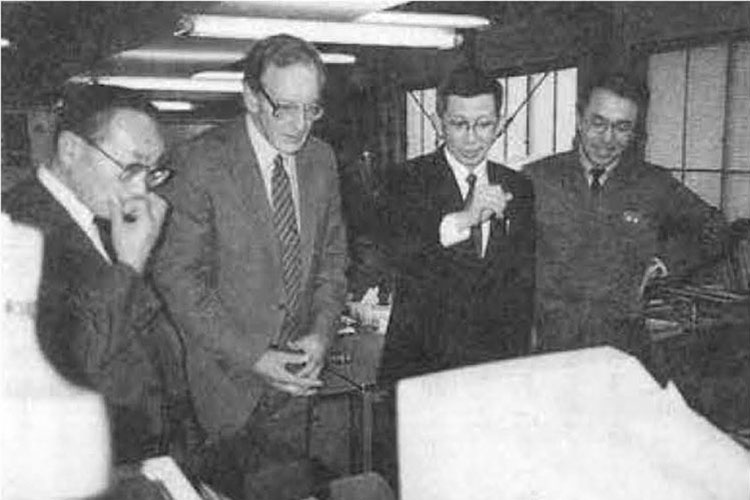
- 拡大
- January 1987 with Dr. Severinghaus
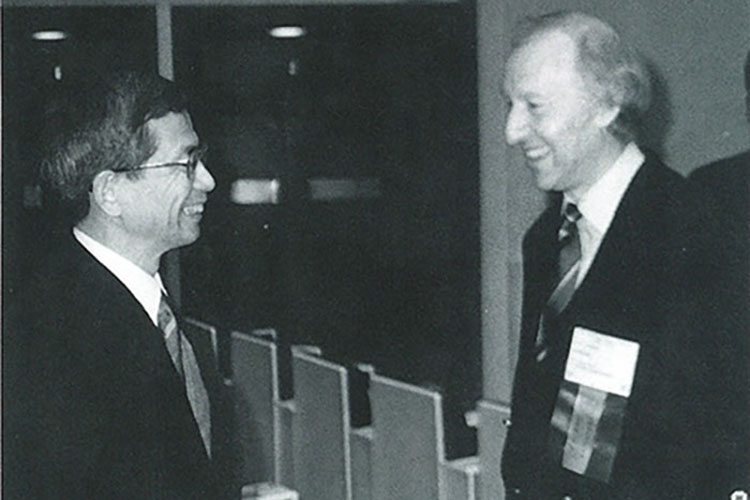
- 拡大
- Fall 1992, IEEE-EMBS Annual Scientific
Meeting With Chairman Rolf
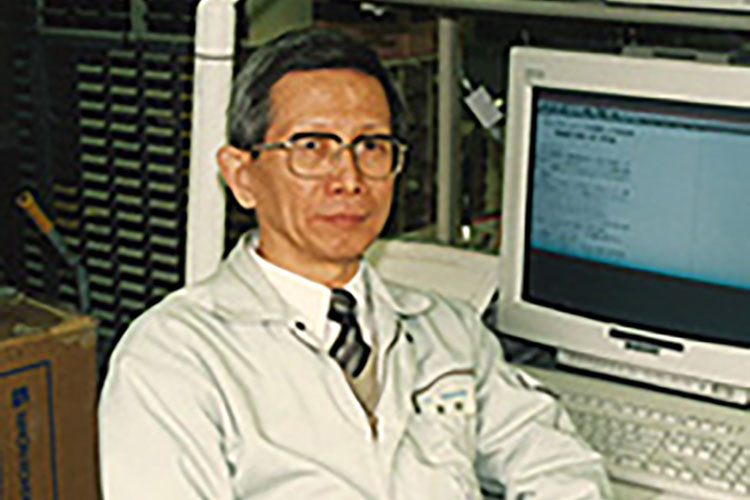
- 拡大
- February 1994, at our laboratory
The pioneering invention of the pulse oximeter was recognized for its significant contribution to improving the quality of medical care. It received the Medal with Purple Ribbon in 2002, and the Institute of Electrical and Electronics Engineers (IEEE) confirmed the technology in the medical field in 2015. He was the first Japanese to receive the “IEEE Medal for Innovations in Healthcare Technology”.
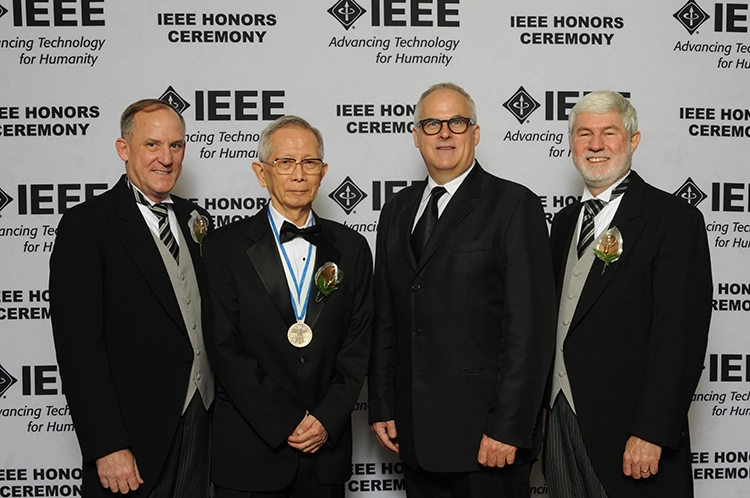
- 拡大
- 2015 IEEE Honors Ceremony at the venue
Even after the pulse oximeter had spread all over the world, Aoyagi was determined to improve the pulse oximeter technology and to apply the principles to other medical measurements. For these purposes, he continued to pursue theoretical research until his later years. Mr. Aoyagi, who seemed to be a very research-oriented person but was actually a friendly person, said, "If the pulse oximeter doesn’t have a solid theoretical grounding, it will be useless." He was also focused on the guidance of young engineers.
In April 2020, Mr. Aoyagi died at the age of 84 due to old age, while the importance of pulse oximeters is being recognized again with the spread of the COVID-19 virus.
Half a century after the principle of the pulse oximeter was first discovered, its technology has spread to medical sites around the world, dramatically improving the safety of general anesthesia surgery, and the saving lives of many patients around the world. Indeed, it can be said that the invention of the pulse oximeter was a great achievement in the history of the world.
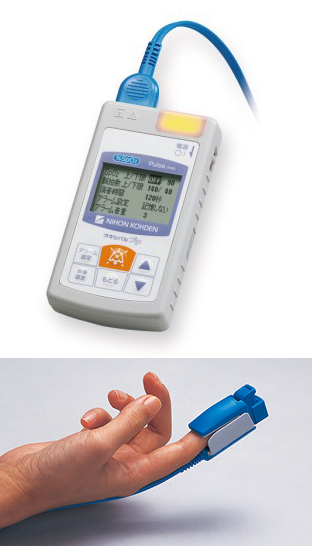
- 拡大
- Pocket SpO₂ monitor with WEC-7201 (top)
Finger probe TL-201T (bottom)
Nihon Kohden today announced that the principle of the pulse oximetry invented by Nihon Kohden engineer, the late Dr. Takuo Aoyagi and others, has been honored as an IEEE Milestone*2 by the Institute of Electrical and Electronics Engineers of America (IEEE)*1. A commemoration ceremony was held today at the headquarters of Nihon Kohden and the milestone plaque was presented by the IEEE. The Company also held a commemorative lecture on the pulse oximeter by Naoki Kobayashi, a fellow of the Ogino Memorial Laboratory, who had worked under Dr. Aoyagi.
The reason for this recognition is that the pulse oximeter has been highly evaluated for its significant contribution to improving the quality of medical care.
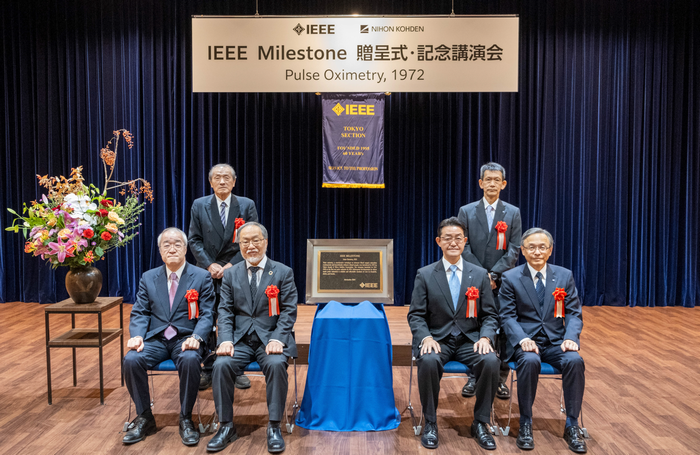
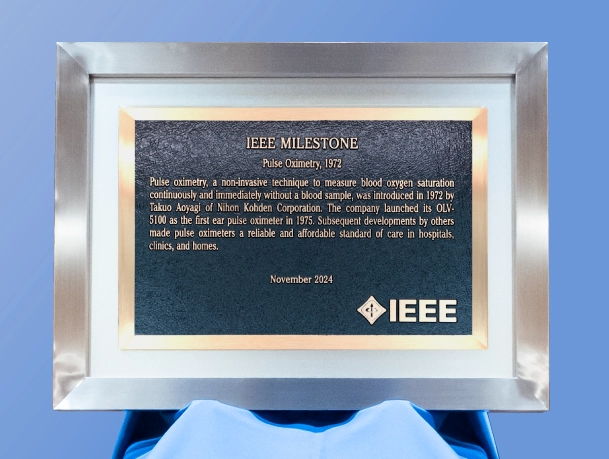
|
IEEE MILESTONE Pulse oximetry, a non-invasive technique to measure blood oxygen saturation continuously and immediately without a blood sample, was introduced in 1972 by Takuo Aoyagi of Nihon Kohden Corporation. The company launched its OLV-5100 as the first ear pulse oximeter in 1975. Subsequent developments by others made pulse oximeters a reliable and affordable standard of care in hospitals, clinics, and homes.
November 2024 |
*1 The IEEE (Institute of Electrical and Electronics Engineers, Inc.) is the world’s largest technical professional association headquartered in the U.S. With more than 420k members in more than 160 countries, the IEEE is dedicated to advancing technological innovation for the benefit of humanity and society.
*2 The IEEE Milestone program recognizes significant achievements in electrical and electronic, information, and telecommunications that have contributed to the development of society and industry in the 25 years or more since their development.
- Nihon Kohden Corporation, February 1971 – Present
Chief Manager of Aoyagi Research Laboratory: Apr. 1991 – Present
General Manager of Development Department: Aug. 1985 – Mar. 1991
Deputy General Manager of Engineering Department: Aug. 1983 – Jul. 1985
Deputy Senior Manager of Development Department: Aug. 1979 – Jul. 1983
Deputy Senior Manager of Engineering Department: Sep. 1975 – Jul. 1979
Manager of Development Department: Feb. 1971 – Aug. 1975
- Shimadzu Corporation, April 1958 – January 1971
Doctor of Engineering (The University of Tokyo)
Title of thesis: Non-invasive measurement of light absorption in blood based on pulsatile variation of light transmitted through body tissue (July 1993)
Supervisor: Prof. Masao Saito, Faculty of Medicine, The University of Tokyo
- November 2024
IEEE Milestone from Institute of Electrical and Electronics Engineers - October 2021
Honorary Member Award from American Society of Anesthesiologists - June 2015
IEEE Medal for Innovations in Healthcare Technology from Institute of Electrical and Electronics Engineers - January 2013
Gravenstein Lifetime Achievement Award from the Society for Technology in Anesthesia - June 2012
Harvey W. Wiley Lifetime Achievement Award from Innovations and Applications of Monitoring Perfusion, Oxygenation and Ventilation - April 2002
Medal with Purple Ribbon from Japanese government - April 2002
Social Award from Japanese Society of Anesthesiologists - April 2000
Science and Technology Achievement Award from Japanese Science and Technology Agency - March 1997
Okusyu Memorial Award from Japan Association for Clinical Monitoring - June 1995
Achievement Award from Japanese Society of Medical Instrumentation
-
April 27, 2020 Press Releases
Notification of the Passing of Dr. Takuo Aoyagi (Message from Ogino, Representative Director, President and CEO) - Key Technologies > Pulse Oximetry
-
October 12, 2021 Press Releases
Nihon Kohden’s Late Takuo Aoyagi, PhD, Receives American Society of Anesthesiologists Honorary Member Award -
November 14, 2024 Press Releases
The principle of the pulse oximetry invented by the late Dr. Takuo Aoyagi and others was recognized an IEEE Milestone

